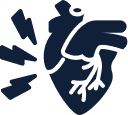Cardioversion
What is electrical cardioversion?
Electrical cardioversion is usually recommended for people with difficult to control atrial fibrillation (or atrial flutter) as a temporising measure. It involves an electric shock delivered through pads placed on top of the chest. The shock is intended to reset the heart rhythm. You will be asleep for the procedure and unaware of the shock. It is very common and can be performed as many times as needed during your lifetime.
Electrical cardioversion is also known as “direct-current” or DC cardioversion. Cardioversion works immediately almost all the time. It is important to note that it may not keep you in rhythm. Response and control of atrial fibrillation is highly variable between people. In some, your AF can return before you leave the hospital. If your AF recurs, your doctor will discuss more options with you.
Why do I need a cardioversion?
If you have atrial fibrillation or atrial flutter your heart might beat too fast and might be irregular. This might make you feel short of breath, tired, or lightheaded. Cardioversion helps people to have normal/regular heartbeats again.
What is a TOE (Transesophageal Echocardiogram) and do I need one?
Your doctor will tell you if you need a TOE before your cardioversion. The procedure lets your doctor check if there is a clot in your heart prior to resetting your rhythm. If a clot is found, the procedure will be abandoned, and further measures put in place to resolve the clot prior to reattempting. Many cardioversion patients will need a TOE.
What should I do before a cardioversion?
You would usually be on uninterrupted anticoagulation prior to your cardioversion. You will need to take the anticoagulants for at least 3-4 weeks before the cardioversion and continue without interruption for at least 4 weeks after.
If you have a TOE, you might not need four weeks of continuous uninterrupted anticoagulation.
In general, you will receive a letter with instructions and steps required prior to your procedure including, date of admission, fasting instructions, medications to stop and items to bring with you. Arrange for a family member or friend to pick you up from hospital.
What are the risks of a cardioversion?
Common risks and complications (more than 5%) include:
- Skin irritation/redness from adhesive pads.
- Recurrence of Atrial Fibrillation (AF) within 12-24 months.
- The procedure may not be successful. Abnormal heart rhythm may persist.
Rare risks and complications (less than 1%) include:
- Development of another arrhythmia.
- May require a pacemaker. This is usually due to an underlying heart condition
- Injury to the food pipe related to the ultrasound used during the procedure.
- Heart attack
- Stroke with lifelong disability
- Death because of this procedure is rare
- Damage to your dentition
- If the heart rate is too slow, a pacemaker maybe required
What happens during the procedure?
Two defibrillator pads will be placed on your chest. The pads are connected via a cable to an external defibrillator. The defibrillator lets us watch your heart rhythm and to deliver the electric shock. There will be a doctor, nurse, and an anaesthetist there for your procedure. They will monitor your breathing, blood pressure and heart rhythm. You will be fully asleep for the procedure once the anaesthetist injects a special medication through the IV cannula. You will not feel the shocks(s). The doctor will give you the electric shock through the defibrillator which can be repeated up to 3 times at that procedure. Although the delivery of shock treatment is only seconds, the whole process takes about 30 minutes.
What happens after the procedure?
At the end of your procedure, your doctor will confirm that you are in normal rhythm prior to removing the patches. You will be monitored closely in recover for a few hours before you can be discharged home.
What happens after discharge?
Follow up:
- An appointment will be made for you to be seen in clinic about 2 months after the procedure
- If you do not receive a date for an appointment within 8 weeks, please call the clinic and ask to speak to the secretary
Medications:
- Continue your medications as instructed. If you are uncertain about your medications, please ring the rooms for clarification
Postoperative care:
- Avoid strenuous exercise for 2-3 days
- You will not be able to drive for the rest of the day
Please contact the rooms if you have any questions or concerns at any time.
In recommending this procedure your doctor has balanced the benefits and risks of the procedure against the benefits and risks of not proceeding. Your doctor believes there is a net benefit to you going ahead. This is a very complicated assessment.







